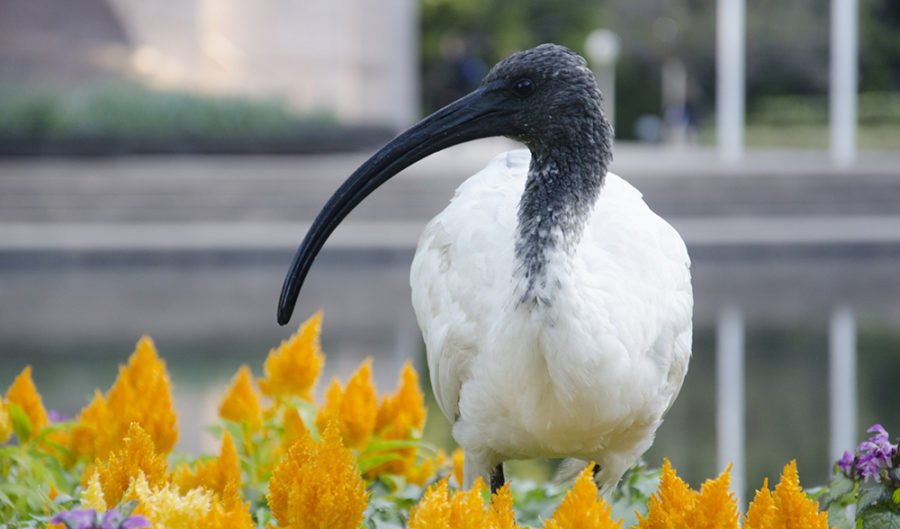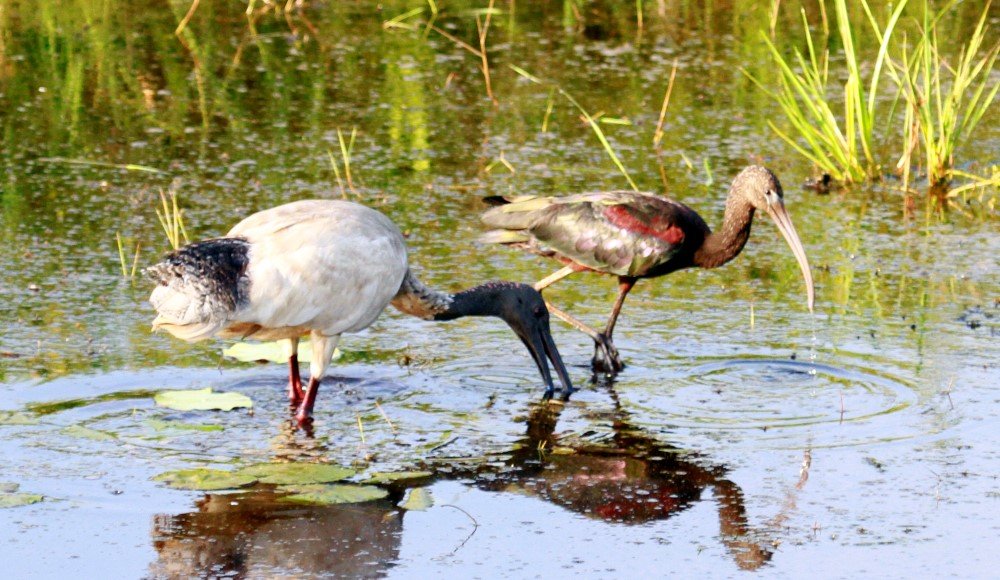The smelly canary in our cities

Let’s consider the ibis: a bird, the butt of jokes, and an Australian icon. If you are one of the 90 per cent of Australians living in an urban area, you’ll probably know of them. Formally the Australian white ibis (Threskiornis molucca), they are striking birds, large and cream coloured, muck-stained as they stride down the street, leaping onto bin rims with defiant integrity and dunking their bald, wrinkled heads into unknown waste.
Their face tapers to a bizarre curved beak often lost in a saucy kebab wrapper. They strut about on long legs and toes, scaly and leprous like their heads. Making them stranger yet, their tails are adorned with frayed black feathers, while the undersides of their wings bear a red-raw streak of arm.
And yet, the public seem most offended by their nests – a honking, squawking mess in the canopy of street-side palms.
“Canary Island date palms – that’s their preferred nesting tree,” says Vicki Currie, Biodiversity Team Leader for the Inner West Council in Sydney. “They’ve got just the right density of foliage for nesting, and the structure to support the birds’ weight. We’ve got lots of palms. And where you’ll find the palms, you’ll find ibis nesting.”
What hits you first about the nests is not the sight, but the unique smell: dank, bitter, and stale, like garbage drying in the sun. It’s oddly tied to the city and to the ibis, and I’ve wondered about its true source.
I told Vicki about the palms near my house in Petersham, also in Sydney’s Inner West. “Actually,” she said, “I received a call from one of the residents there last week. The ibis numbers have been growing over the last three years, and this season it’s been particularly bad – with baby ibis being pulled from the trees by crows and eaten on the street. The residents took some to the vets or even adopted them, but we’ll need to do something soon.”

City-slicker. An urban ibis with a wingtag, 059-yellow, part of a large-scale study into ibis movement and foraging patterns conducted with the Australian Museum, NSW National Parks, and the Royal Botanic Garden Sydney. (Image: Ronald Woan/flickr)
Despite all this, the Australian white ibis remains an icon. Dedicated to ibis are dozens of Facebook groups with thousands of committed followers, paintings, comics, blogs, costumes, and radio shows. Somehow, the cultural spotlight has landed on the ibis’ hooked and unsuspecting face in the crowd and it’s there to stay: a funny-looking thing for us all to mock, a sanctioned target for jokes and memes, an avian Rob Schneider or Nickelback.
How old is this joke, though? Ibis are native birds and have been in Australia for millennia. Were people laughing at the ibis during the Sydney 2000 Summer Olympics? Perhaps. How about the launch of the Surfers Paradise hotel on the Gold Coast during the 1920s — were we scoffing at scungy city ibis then?
No, because there was no such thing as city ibis then.
Looking at 1950s Sydney alone, there were few counts of ibis. Contrast that with Sydney 2014 and almost 9000 ibis were counted in the annual ibis census. Urban ibis are new.
So — why did thousands of birds choose to land in cities around the country to dodge cars and cats, eat festering refuse, and bear the brunt of hisses, hurls, and glares? Let’s take a trip to the country to find out.
The Murray-Darling Basin stretches across western New South Wales, Victoria, the Australian Capital Territory, Queensland, and South Australia, collecting six per cent of Australia’s rainfall and providing habitat for 367 species of birds and 85 species of mammals. It was also once the primary habitat of the Australian white ibis.
The pre-colonial basin was lush, with the white ibis just one of 98 species of waterbird. Large white and glossy, ibis in their traditional habitat stride elegantly through the reeds and mudflats, their curved beak supremely adapted for sliding into the squelchy mud, sensitive to detect and extract crayfish, mussels and other tasties. Their heads are featherless, hygienic, and easy to keep clean. Contrasted against white plumage, their tail feathers are fringed with delicate, black lace-like feathers — the undersides of their wings glowing a rosy red when courting mates.

An Australian white ibis fossicking for aquatic invertebrates in a traditional habitat alongside a glossy ibis. (Image: Flickr/Geoff Whalan)
The basin has changed substantially since, and today is used intensively for agriculture and drinking water, supporting up to 4 million Australians. Our heavy reliance on the basin has come at the cost of our precious wildlife. As the wetlands dried up over the decades, ecosystems began collapsing — less water meant less plants, and less invertebrates, less fish, mammals, and birds.
According to historical observations provided by the Murray-Darling Basin Authority, 20 out of the 85 species of mammals living around the basin have become locally extinct since European settlement. And that’s just mammals. Not the ibis, though. A honking wretch of an alarm, ibis were adaptable and enduring enough to flee the dying wetlands – in the shape of a large V – to the big smoke.
The ibis began arriving to town in droves, but instead of heeding their message for the plight of the Murray-Darling Basin, we got distracted by their funny beaks. The ibis landed in our cities – littered with cylindrical food dispensers full of half-eaten sandwiches, fruit, and chicken bits, footpaths where coffee cups rolled and chip packets skated. Once here, the ibis’ city populations boomed, while their wetland counterparts dwindled.
In the wild they eat crustaceans and insects – high fat, high protein foods, explains Sean Coogan, a nutritional researcher at the University of Sydney. “They’re carnivores. In Hyde Park where I study them, though, they seem to eat mostly carb-rich foods: noodles, bread, cookies. They happily eat food from this guy who actually cooks dinner for them the night before: rice with sausage, kale and carrots, and ramen… chicken flavour.”
“It was really funny during my experiments; I’d set out one experimental food in a black container and the ibis would eat from it. But as soon as I’d put out three dishes, the ibis would grow wary. They’re street smart. I ended up having to put the food in transparent containers so they could see it wasn’t a trap,” he says.
“I’m not sure why the ibis are eating such high-carb foods from the trash. I guess it’s all they can find. People typically don’t throw out protein or fats because they’re more expensive. Strangely though, even when given the choice — the ibis still chose carbohydrate-rich experimental foods. What they’re foraging for in the trash has to be an important consideration in any management plan.”
Rubbish is a staple for ibis, and in a sense, their colourful street names — bin chicken, trash turkey — mean more than we realise. A study monitored ibis for three days in Sydney and found that 40-50 per cent of birds fed from landfill daily; our excess has become fuel for the birds, allowing them to turn our waste into more baby ibis. With such decadence to live off, ibis are proliferating. More and more palm trees are becoming nests, stinky and noisy, and in some councils they must be ‘managed’. Our trash has manifested into walking, squawking animals and we don’t like it.
That familiar stench drifting from ibis nests? It’s not the smell of the birds, but of our own rubbish, our neglectful and disposable decisions coming home to roost. Ibis are a pungent indicator of our vast environmental footprint: they’re our smelly canaries.
But it’s not all doom and gloom, for the Australian white ibis is a paradoxical bird. They are rare where they should be abundant and over-abundant where they shouldn’t be; at the same time they’re both vulnerable and a pest – it’s illegal to harm them, yet councils have permits to cull them. And for all the disgust and jokes cast at them, they wield a great social leverage – each year in October, hundreds participate in the ibis census, counting tens of thousands of ibis over the country. And on 21 December, almost 15,000 Sydney-siders are either ‘interested’ or ‘going’ to an ibis-themed Facebook event … called ‘International Glare at Ibises Day’.

The Australian white ibis. Watercolour paintings by Matteo Grilli at Blogspot, used with artist’s permission.
I asked Sean and Vicki their opinions on the ibis.
“I love them,” says Vicki. “I find it difficult to see them in an urban environment living off scraps. I want to provide them with as much healthy habitat as possible, and get people seeing them in a nice light, like kookaburras or any other Australian icon. They’re beautiful, regal birds.”
“I came here from Canada and thought ‘Wow! These are really cool birds’,” says Sean. “Over time I saw them eating garbage and started to think they were gross. But then I started working with them and learned individuals, their personalities – some liked carrots, some didn’t, some were bold, some were flighty. I had a lot of fun in the gardens feeding those birds. And you know what’s weird? I even started to like their smell – it’s something.”
Ibis have our attention, for good and bad, and it can be channelled for change. Their social media appeal needs to be curbed for good, not inane. Spread the plight of the ibis, dispose of your rubbish properly, don’t waste food (food created on farmland irrigated by the Murray-Darling), and respect ibis. Next year, let’s see ‘International Care for Ibises Day’.
For more information on the Australian white ibis community survey, visit the page.
Jesse Hawley works as a Communications Advisor on CSIRO’s social media team. Outside of this role he’s a passionate science writer and illustrator, depicting subjects from marsupial lions to tummy terraria, household piranha plants to humans as disoriented apes. He has a special love for comedy and everything evolutionary.

